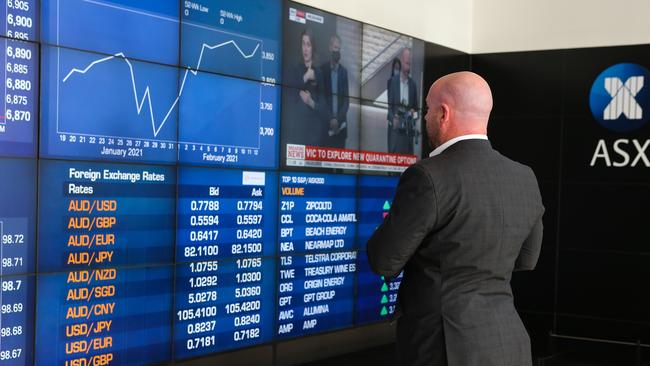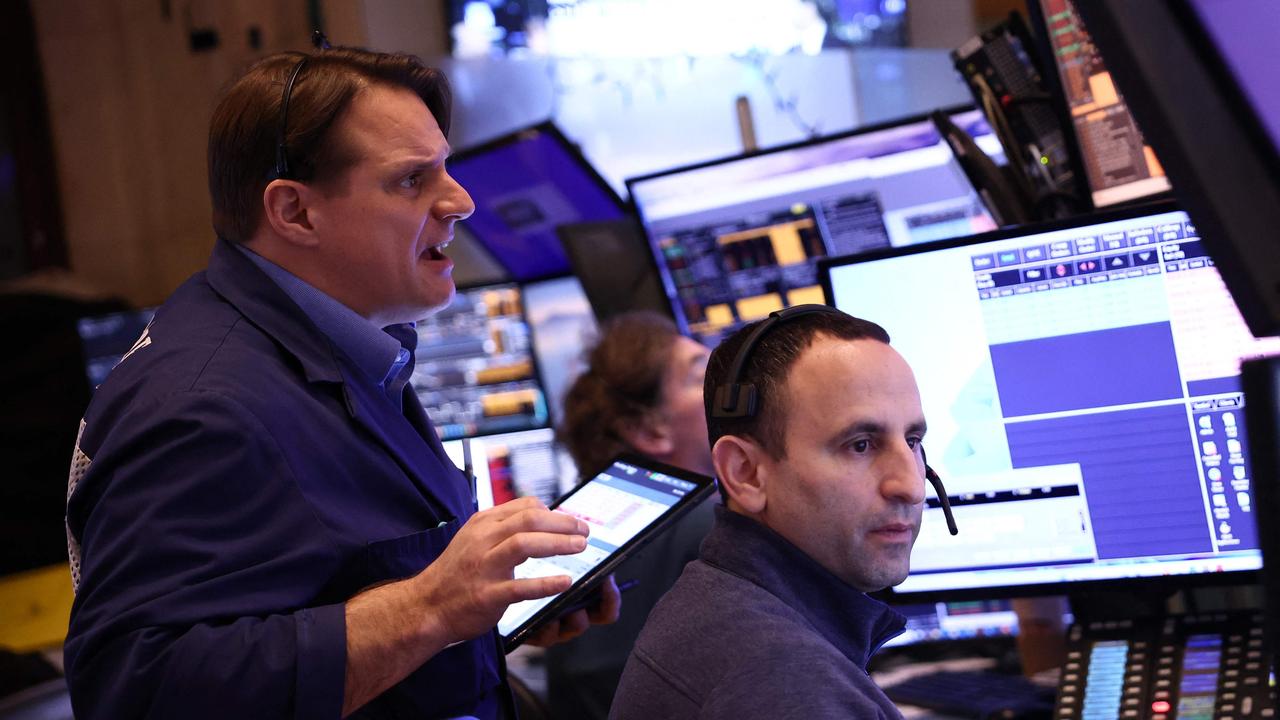ASX takes $51bn hit on worst day in 6 months
High flyers like Kogan, Afterpay and Dominos slammed as investors wiped $51bn off the local sharemarket and the Australian dollar dived.

The Australian dollar dived and investors wiped $51bn off the local sharemarket, while 10-year bond yields surged to a 12-month high, at the end of a torrid week as the global “bondcano” began to erupt with surging yields starting to cause broadbased risk aversion in global markets.
The Aussie had hit a three-year high above US80cs on Thursday as COVID-19 vaccinations in Australia, and rapidly falling cases and deaths, along with stronger-than-expected economic data in the US fuelled expectations of a strong global rebound — buoying commodity prices and long-term interest rate differentials.
But on Friday it dived 2.3 per cent to a five-day low of US78.20c as a massive spike in US bond yields pushed the S&P 500 down 2.5 per cent, while driving the Nasdaq down 3.5 per cent.
Risk aversion flowed through to the local sharemarket with the S&P/ASX 200 index falling 160.73 points, or 2.35 per cent, to 6673.3 – its worst day in six months – after hitting an almost four-week low of 6658.9 points in early trading. The index hit a 12-month high of 6917.3 points last week.
After weighing on tech stocks and other high-PE “COVID-19 winners” all week, the bond market explosion – which severely tested the Reserve Bank’s “yield curve control” and “quantitative easing” bond buying programs this week — started to cause broadbased risk aversion in shares, with BHP down 2.6 per cent, Fortescue down 4.5 per cent and Wesfarmers down 2.4 per cent.
The high-flying Technology, Consumer Discretionary and Health Care sectors were worst off, with Afterpay down 11 per cent, Kogan sliding 10 per cent and Domino’s Pizza dropping 5.6 per cent.
“Taper Tantrum is finally upon us, triggered by the Reserve Bank losing control of the 3-year bond target, the US Treasury’s 7-year bond auction tailing by 4.4 basis points, and US 10-year real yields rising as much as 25 basis points intraday,” said Stephen Innes, chief global markets strategist at Axi.
“With discussions among the US Democrats pointing to as much as $US3 trillion ($3.8 trillion) in infrastructure spending and the pandemic continues to normalise, bond traders wasted little time pricing in a hyper-stimulated and inflated return to normalcy, triggering massive sectoral dispersion, with technology stocks under the hammer given growing valuation concerns.”
With a $US1.9 trillion ($2.4 trillion) Washington stimulus package likely to come in mid to late-March and the economy continuing to normalise, the stage may be set for QE taper discussions — although, in reality, the market has been preparing for it for some time now, with its 2013 playbook in hand, Mr Innes added.
Tech stocks are potentially some of the most susceptible to rising yields because their value rests heavily on future earnings, which get discounted more negatively when bond yields rise.
The sell-off on Wall Street also hit other markets in the Asia Pacific region on Friday.
Japan’s Nikkei 225 dived 4 per cent, the Hang Seng index lost 3.2 per cent, China’s CSI 300 fell 1.8 per cent, South Korea’s KOSPI lost 2.8 per cent and Taiwan’s TAIX tumbled 3 per cent.
With G20 finance ministers and central bank governors due to hold virtual meetings on Friday, traders were alert for rhetoric that could slow the rise in bond yields and support equities.
While ECB chief Christine Lagarde pushed back against a rise in eurozone bond yields on Monday, Fed chairman Jerome Powell took a different tack, emphasising the steepening bond yield curve as a sign of confidence, while indicating that the Fed is a long way from achieving its targets for the labour market and inflation and that it will communicate any tapering a long way in advance.
“For all the speculation about the timing of another ‘taper tantrum’, it appears that we might have already stumbled into one,” said Royal Bank of Canada Asia FX strategist, Alvin Tan.
“The market has priced in a Fed rate hike by early 2023, paying no heed to the ‘lower for longer’ rhetoric that was voiced just a few days ago. The G20 finance ministers meeting provides another opportunity for policymakers to make a stand.”
But good news on the economy and the pandemic has temporarily become bad news for equities and is now causing an explosion of the “bondcano”, said Hasan Tevfik, senior analyst at MST Marquee.
His original bondcano thesis after the global financial crisis was that a “mismatch” of supply and demand for bonds would drive yields sharply higher – as occurred in mid-2013 after the Fed flagged the eventual (but later delayed) start of tapering of its bond buying.
It aimed to predict the effects on different kinds of companies of sharply rising yields, with “bond proxies”, high PE growth stocks and – at times the broader market – in the firing line.
“I think that’s what you’re seeing right now,” he told The Weekend Australian.
“The rise in bond yields in the last two weeks has been driven almost exclusively by a rise in real (inflation adjusted bond yields measured by Treasury Inflation-Protected Securities) interest rates – which are function of the supply and demand for government bonds – plus inflation expectations, which have risen to some degree with commodity prices, but main driver is rising real yields.
“It has become blatantly obvious that the US government is going to supply more bonds, so not only are they are step closer to passing this $US1.9 trillion package – which is massive – but US Treasury Secretary Janet Yellen was quoted on Monday about the ability to issue even more debt.
“So she has changed the focus from debt-to-GDP to interest expense-to-GDP (ratios).
“That can be a little bit dangerous. Not only are you seeing (bond) supply coming through now, you could actually see supply come through later on as well (from budget deficit financing, assuming no acceleration of QE), and this is in the backdrop of sharply-recovering economic activity.
“At the same time, the Fed has said ‘things are fine, we are not going to tighten any time soon’, but they didn’t say anything about easing either, so you’re getting this supply increase from bonds without the offsetting demand increase in bonds (from an accelerated pace of QE).”
While US and Australian corporate earnings estimates and commodity prices rose sharply in the recent earnings periods, the concern is that the rise in bond yields is leaving earnings behind.
Still, while the consensus estimate for Australian earnings per share growth have been revised up to 20 per cent for calendar 2021, Mr Tevfik believes analysts are underestimating calendar 2022 growth after “pulling forward” much of the growth they had previously expected next year.
His target for the S&P/ASX 200 this year remains 7000 points.
But Mr Tevfik does see a “headwind” for equities from rising bond yields.
“The growth will be delivered by those companies which have suffered from COVID-19 and are in the process of recovery, but some of the COVID-19 darlings are looking forward to an earnings hole and are sitting on twenty times plus PE ratios, which are very sensitive to rising discount rates.”
After the extreme bond market volatility of the last week, markets will be looking for a “firm response” from the Reserve Bank at its monthly board meeting next Tuesday, according to Royal Bank of Canada’s head of Australian and New Zealand fixed income and commodity strategy, Su-Lin Ong.
With 10-year bond yields 70 basis points higher, the 10-year AU/US spread 35 basis points wider and the Aussie dollar Trade-weighted Index 4 per cent higher than a month ago when the RBA announced a second round of quantitative easing, it “may well opt to “strengthen its language and measures” at the meeting.
“At a minimum, we would expect a step-up in yield-curve control for the next couple of weeks — possibly including more purchases on non QE operation days — plus the possibility that any further and sustained market dislocation forces the RBA to step in and buy across the curve in greater size than the standard $5bn weekly QE schedule,” Ms Ong said.



